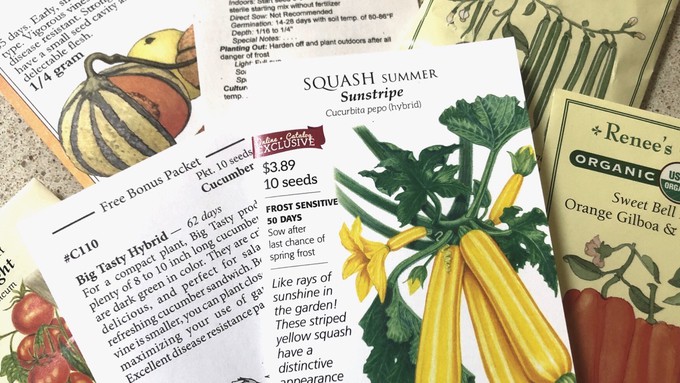
Organize your own local swap for Jan. 28

Get those excess seeds working in someone else’s garden — swap them! Kathy Morrison
It’s a January gardener preoccupation: Seed shopping. Whether browsing catalogs or online websites, we are constantly tempted by “new and improved” or “best ever” varieties as well as vegetables or flowers we’ve never seen before.
The result? Quite often, we accumulate too many seeds! It's time to do some seed swapping.
Saturday, Jan. 28, is National Seed Swap Day, a coast-to-coast gardener initiative to get more seeds and gardens growing.
To be held on the last Saturday of each January, National Seed Swap Day was launched by Washington Gardener magazine, a mostly online publication dedicated to gardening in the nation’s capital and surrounding areas. It has an official website, https://seedswapday.blogspot.com/, which lists upcoming seed swaps and encourages others to share their unwanted (or unplanted) packets.
National Seed Swap Day is local and totally grassroots. Gardeners in any kind of group – community garden, club, church, neighborhood, work, etc. – set a time and place, then bring their excess seeds. They can break down a packet (do you really need 30 of the same tomato variety?) or trade last season’s seeds that are still viable. Seeds are packed fresh for each season for maximum germination rate, but most vegetable, herb and flower seeds remain viable for at least two or three years.
It’s likely other gardeners will appreciate those seed swap offerings.
U.S. nurseries and seed distributors are still catching up with record demand for garden seeds. During the pandemic, major seed houses such as Peaceful Valley Organic sold out of almost all their stock, frustrating many gardeners.
According to the National Garden Bureau, seed customers should find better inventory this season – but get your orders in early – then be patient.
“Seed companies are likely to experience delays in times of high demand so be aware of that company’s current timeline for shipping,” advises the bureau. “They will be transparent. Sign up for or subscribe to that company’s communications to stay informed and up-to-date.”
Seed demand is expected to remain high all year, says the bureau, so go ahead and order your fall seeds now along with seeds for spring and summer planting.
“Don’t buy just for spring because succession sowing is important for season-long harvest and there are wonderful vegetables like cabbage and kale that are great for fall plantings,” the bureau says.
For more about seeds and seed shopping, check out these tips from the National Garden Bureau: https://ngb.org/2021/01/28/ask-the-experts-about-seedfacts/.
For more on National Seed Swap Day: https://seedswapday.blogspot.com/.
Comments
0 comments have been posted.Sacramento Digs Gardening to your inbox.
Sites We Like
Garden Checklist for week of May 5
Survey your garden after the May 4 rainstorm. Heavy rain and gusty winds can break the neck of large flowers such as roses. Also:
* Keep an eye on new transplants or seedlings; they could take a pounding from the rain.
* Watch out for powdery mildew. Warmth following moist conditions can cause this fungal disease to “bloom,” too. If you see a leaf that looks like it’s dusted with powdered sugar, snip it off.
* After the storm, start setting out tomato transplants, but wait on the peppers and eggplants (they want warmer nights). Pinch off any flowers on new transplants to make them concentrate on establishing roots instead of setting premature fruit.
* Trim dead flowers but not leaves from spring-flowering bulbs such as daffodils and tulips. Those leaves gather energy to create next year's flowers. Also, give the bulbs a fertilizer boost after bloom.
* Pinch chrysanthemums back to 12 inches for fall flowers. Cut old stems to the ground.
* Mulch around plants to conserve moisture and control weeds.
* From seed, plant beans, beets, cantaloupes, carrots, corn, cucumbers, melons, pumpkins, radishes and squash.
* Plant onion sets.
* In the flower garden, plant seeds for asters, cosmos, celosia, marigolds, salvia, sunflowers and zinnias. Transplant petunias, zinnias, geraniums and other summer bloomers.
* Plant perennials and dahlia tubers for summer bloom.
* Don’t wait; plant summer bulbs, such as gladiolus and tuberous begonias.
* Harvest cabbage, lettuce, peas and green onions.